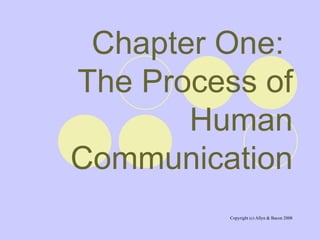
Chapter1
- 1. Chapter One: The Process of Human Communication
- 17. Ten Misconceptions of Communication
- 21. How Did We Get Here? A Brief History of the Field of Communication Studies
- 23. Ptah-Hotep The Instruction of Ptah-Hotep was written by Ptah-Hotep for the Pharaoh Djedkare Izezi’s son as guidance in effective communication and leadership in approximately 2200 b.c. in Egypt.
- 24. The Sicilian Thinkers 1) Totalitarian regime headed by Thrasybulus had stolen property from countless Sicilian citizens. 2) After the overthrow of Thrasybulus’ regime, a more democratic state was established.
- 25. The Sicilian Thinkers 3) In this new democratic state, Sicilian citizens who had property taken during Thrasybulus’ reign could go to court and attempt to recover their property.
- 26. The Sicilian Thinkers Corax and his pupil Tisius wrote the first manual on public speaking.
- 27. Greek Thinkers
- 30. Four Signs of Increased Rhetoric in City States 2) Dividing a speech into parts 3) New interest in prose styles 4) Study of philology: Study of words. [dictionary]
- 32. The Whores of Rhetoric
- 38. A Man Called Socrates
- 39. Debate over Authentication of Socrates
- 40. Differing Voices Alluding to Socrates 1) In Thucydides’ History of the Peloponnesian War, Socrates was a brave warrior. 2) In Xenofon’s Memoribilia, Socrates is depicted as fairly dull, non insightful, and wrote that Socrates was often ridiculed by the Athenian people.
- 41. 3) In Aristophanes’ comedic play The Clouds, Socrates is depicted as a slightly buffoonish teacher who always has his head in the clouds. 4) Antisthenes wrote about his time in jail with Socrates shortly before he was executed.
- 42. 5) Diogenes of Sinope believed that Socrates was the intellectual founder of the Cynics because they were protesting the same types of issues. 6) Aristotle Primarily gives us a timeline on Socrates the actual man (470-399 BC).
- 43. 7) Plato was a student of Socrates and is credited with writing what we really know about Socrates’ beliefs on Rhetoric.
- 44. The Dialectic (Basis of the “Socratic Method”)
- 45. Step One Logical Argumentation – Won’t exactly keep you up at night!
- 46. Step Two Strip Away The Ignorance – Show that someone has a clearly knowledge gap and that they haven’t really thought an argument through.
- 47. Step Three Demonstrate a Lack of Reflection on Their Part – Show the person that if they had really reflected on an argument, they would have come to your side)
- 49. Step Five Changing of the Soul - This process leads to a chemical transformation where a person is holistically changed.
- 50. Two Important Works by Plato
- 51. Gorgias Plato wrote that sophistry was akin to trickery .
- 52. Phaedrus 1) Non-lover: someone who didn’t care about her/his relational partner. 2) Evil-lover: someone who intended to manipulate her or his relational partner. 3) Noble-lover: someone who cared about her or his relational partner and did not have an ulterior motive for the relationship.
- 53. Aristotle
- 54. Rhetoric The ability to recognize and implement all of the available means of persuasion in a given situation.
- 55. Aristotle's Rhetori c Aristotle's Rhetori c consists of three books: one focusing on the speaker, one on the audience, and one on the speech itself. The Rhetoric is considered by historians, philosophers, and communication experts to be one of the most influential pieces of writing in the Western world.
- 56. Two Assumptions of Aristotelian Theory
- 57. Effective public speakers must consider their audience.
- 58. Proofs Inartistic Proofs - Objects you can physically bring to a speech (witnesses, laws, oaths, contracts, torture)
- 59. Artistic Proofs 1) Ethos – ethical credibility 2) Pathos – emotional appeal 3) Logos – logical appeal
- 60. Types of Rhetorical Speeches 1) Forensic: Court room speeches. 2) Epideictic (ceremonial): Speeches that praise, honor, blame or shame. 3) Deliberative: Speeches associated with the future-what an audience will do or think as a result of a speaker's efforts.
- 61. Roman Thinkers
- 66. From Late Antiquity to the Renaissance
- 68. Plotinus (d. 270 AD) and Neo-Platonism Greek philosopher alive a generation before Christianity became the official religion in Rome. Combined Plato’s ideas along with the Stoics and Aristotle’s to create a new breed of philosophy called Neo-Platonism.
- 69. Augustine (St. Augustine of Hippo)
- 73. De Doctrina Christiana In this text, Augustine creates a new intellectual field called semiotics, or the study of signs and signifiers. Sign: A thing which, in addition to the impression it makes upon the senses, makes something else come into our thoughts.
- 78. The Renaissance
- 82. British Thinkers
- 85. Rhetoric is on one hand an effect and on the other hand an expression of the power to get people to view the world from your point of view.
- 86. The Colonial Period in America (1492–1783)
- 94. The Twentieth Century
- 95. James A. Winans vs. Everett Lee Hunt Winans wanted rhetoric to be more scientific. Hunt believed that the scientific approach was antithetical to the enthusiasm and inspiration that was needed for good public speakers.
- 96. Carl Hovland & The Yale Studies Post Hitler studies that focused on propaganda and persuasion. The studies focused on how senders persuade people.
- 101. The Rise of the Social Sciences
